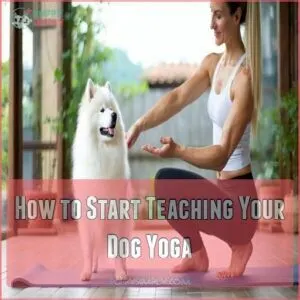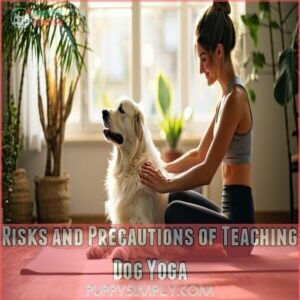This site is supported by our readers. We may earn a commission, at no cost to you, if you purchase through links.
 Teaching dog yoga isn’t just about striking poses – it’s a tail-wagging journey of connection that started with Suzi Teitelman in 2001.
Teaching dog yoga isn’t just about striking poses – it’s a tail-wagging journey of connection that started with Suzi Teitelman in 2001.
You’ll want to set up a quiet space with a non-slip mat and your pup’s favorite treats. Start with short sessions when your furry friend is calm, using gentle praise to encourage participation.
Like teaching an old dog new tricks, patience is key – never force poses and always watch for signs of enjoyment. This gentle practice reduces anxiety, improves flexibility, and strengthens your bond.
From relieving arthritis to managing weight, the benefits of this peaceful practice might surprise you.
Table Of Contents
What is Doga?
Imagine your furry friend joining you on the yoga mat, creating a pawsitive zen experience together.
That’s doga – dog yoga – a delightful practice started by Suzi Teitelman in 2001 that combines traditional yoga with canine companionship.
Unlike regular yoga, doga isn’t about perfect poses or strict routines. Instead, it’s a relaxed way to bond with your pup through gentle movements and shared energy.
Whether you’re a yoga pro or complete beginner, this unique form of animal therapy welcomes all skill levels. Think of it as a tail-wagging twist on wellness that’s taking the pet world by storm.
To keep your dog’s energy up during these sessions, consider using a dog food storage container to maintain freshness.
Benefits of Doga
You’ll be amazed at how dog yoga can transform your pup’s physical and mental well-being, from reducing anxiety to improving flexibility and circulation.
If you’re looking to strengthen your bond while helping your furry friend stay healthy, you’re in for a treat with these gentle exercises that’ll have both of you feeling zen in no time, and improve your pup’s overall well-being.
Physical Rehabilitation for Dogs
Your furry friend’s road to recovery just got a tail-wagging boost with dog yoga.
Physical rehabilitation through doga offers a gentle yet effective path to healing, especially for pets recovering from injuries or surgery.
Here’s how doga supports canine therapy and pet wellness:
- Provides low-impact exercises perfect for arthritic or elderly dogs
- Increases mobility and strength through gentle stretching
- Helps competitive canine athletes with injury recovery
- Supports weight management for obese dogs through controlled movements
By practicing dog yoga techniques, pet owners can enhance the well-being of their pets.
Stress Relief for Canines
Regularly practicing doga provides powerful stress relief for your anxious pup through gentle movements and calming techniques.
Studies show that dog interaction reduces cortisol levels. You’ll notice your dog becoming more relaxed during pet relaxation sessions, especially with these proven canine calming methods.
| Technique | Benefit | Duration |
|---|---|---|
| Dog Massage | Reduces cortisol | 5-10 mins |
| Deep Breathing | Calms nervous system | 3-5 mins |
| Gentle Stretching | Releases tension | 5-7 mins |
| Quiet Connection | Promotes peace | 2-3 mins |
These animal therapy techniques help manage your dog’s stress naturally and effectively.
Strengthening Human-dog Bond
Beyond calming your pup’s nerves, dog yoga creates an unbreakable emotional connection between you and your furry friend.
You’ll notice your dog’s trust building as you sync your breathing and movements together.
Through these bonding exercises, you’re speaking your pup’s language of touch and presence, it’s like a play therapy session where you both get to be silly while deepening your canine empathy naturally.
How to Start Teaching Your Dog Yoga
Ready to start your doga journey? Now that you know the amazing benefits, let’s get you and your pup on the yoga mat! Teaching dog yoga doesn’t have to be complicated – it’s all about making it fun and comfortable for your furry friend.
When selecting a mat, consider using a high-quality dog yoga mats to make sure a comfortable and safe experience.
Here’s how to begin your doga practice:
- Set up a quiet space with a non-slip yoga mat and some favorite treats
- Start with short 5-minute sessions when your dog is calm
- Use gentle praise and treats to encourage participation
- Keep movements slow and never force poses
- Watch for signs your pup is enjoying the experience – tail wags and relaxed ears are good indicators!
Remember, patience is key – some dogs take to doga instantly, while others need time to warm up. This is important for a successful and enjoyable yoga experience with your dog, ensuring both you and your pup have a great time together, and it’s crucial to make it fun and comfortable.
5 Best Doga Poses
You’ll love these five doga poses that’ll have your pup stretching and bonding with you like a pro yogi.
Whether you’ve got a mellow mastiff or an energetic chihuahua, these gentle poses will help your furry friend find their inner zen.
These poses will also help strengthen your connection together, while your furry friend finds their inner zen.
Chaturanga
Chaturanga, a classic dog yoga pose, helps your pup build strength while staying relaxed.
Guide your dog to lie on their belly, then gently massage their back in long, soothing strokes.
Here’s what to expect:
| Position | Benefits | Tips |
|---|---|---|
| Belly Down | Improves flexibility | Use gentle pressure |
| Back Straight | Builds core strength | Start with 30 seconds |
| Legs Extended | Promotes relaxation | Reward with treats |
Using the right yoga mat materials is essential for a comfortable practice.
Remember to start slow and let your four-legged yogi set the pace!
Heart to Hound Mudra
After mastering the stretches, let’s explore the Heart to Hound Mudra – a peaceful canine meditation that’ll bring you and your furry friend closer than ever.
This dog yoga pose creates a beautiful heart connection as you sit cross-legged with your pup.
Here’s how to teach your dog this calming exercise:
- Sit on your mat with your legs crossed, inviting your dog to face forward in front of you
- Place one hand over your heart and the other gently on your dog’s chest
- Take slow, deep breaths while maintaining this connection for 1-2 minutes
- If your dog moves away, don’t force it – just invite them back with gentle encouragement
Watch as this bonding exercise transforms restless energy into peaceful moments together. You’ll be amazed at how quickly your pup picks up on your calm vibes!
Puppy Paw Mudra
Anyone can master the Puppy Paw Mudra – it’s like giving your furry friend a spa day! Have your dog lie down with their front legs stretched out.
Kneel behind them, gently place your head on their back, and extend your arms to rest your hands over their paws.
- Start with a gentle paw massage to help your pup relax
- Breathe deeply together for 3-5 minutes
- Use treats to encourage staying in position
- Practice daily for the best bonding results
Watch as your dog melts into this calming pose!
Savasana
Slip into Savasana, the cozy-comfy pose that’ll turn your pup into a puddle of relaxation. This essential dog yoga pose creates a peaceful moment where you and your furry friend can unwind together.
Just like humans, dogs benefit from mindful breathing exercises and calming techniques. To enhance this experience, consider using high-quality dog yoga mats for superior comfort and support.
| Position | Dog’s Role | Your Role |
|---|---|---|
| Starting | Lies on back | Sits cross-legged |
| Middle | Relaxes belly-up | Gentle belly rubs |
| Final | Deep breaths | Synchronize breathing |
Guide your pup to lie between your legs, belly exposed. Keep the environment quiet and soothing. Watch as your dog’s stress melts away with each gentle touch and shared breath. It’s a beautiful bonding experience that doubles as a powerful stress relief technique.
Chair Pose
Moving gracefully into Chair Pose, you’ll guide your pup to sit back on their hind legs while gently supporting their middle back.
This dog yoga pose is perfect for improving canine posture and pet stretching, especially for older or injured dogs.
As you lift their front paws skyward, maintaining animal alignment, you’ll both feel energized.
Don’t forget treats – they’re your best yoga assistance buddy!
To achieve the best results, consider using positive reinforcement techniques to encourage good behavior during dog yoga sessions.
Taking a Doga Class or Practicing at Home
Many dog owners find their perfect zen balance practicing doga at home or in specialized classes.
Whether you’re joining a dog yoga class or creating a safe environment in your living room, the key is starting with simple poses and staying patient.
Here’s what you’ll need to get started:
- A non-slip yoga mat for secure paw placement
- Small, healthy treats for positive reinforcement
- Your pup’s favorite toy for moments when they need a break
- A quiet space away from household distractions
For home practice, start with 10-minute sessions and gradually extend the time as your furry friend becomes more comfortable.
Online resources and video tutorials can guide you through basic poses, but remember – your dog’s comfort always comes first.
Establishing a strong foundation in basic obedience commands is essential for a successful dog yoga practice.
Incorporating Yoga Into Dog Walks and Playtime
You don’t have to choose between walkies and yoga – combine them! Let’s turn your daily dog walks into playful pet stretches that boost both physical and mental wellness.
Here’s how to blend yoga with your pup’s outdoor adventures:
- Start with "pause and pose" moments during walks – when your dog stops to sniff, try a standing forward bend while holding the leash
- Practice synchronized breathing during fetch breaks – take deep breaths as your dog retrieves
- Turn rest stops into mini-meditation sessions with gentle ear rubs
- Mix quick stretches into playtime – try downward dog together between throws
Both you and your furry friend will enjoy these mindful moments together! Mastering dog training basics is essential for a stronger bond during these activities.
Risks and Precautions of Teaching Dog Yoga
While yoga walks can be wonderful, safety should be your top priority when teaching dog yoga.
Before starting doga, verify with your vet to confirm your pup’s health allows for certain poses. Some breeds, especially those with respiratory or back issues, might need modified routines.
Keep an eye on your dog’s comfort level – if they seem stressed or resistant, don’t force poses. For group classes, confirm your dog is up-to-date on vaccines to prevent disease transmission.
Start with gentle movements and always respect your furry friend’s boundaries to avoid any injury or stress, ensuring a positive experience with dog yoga.
















